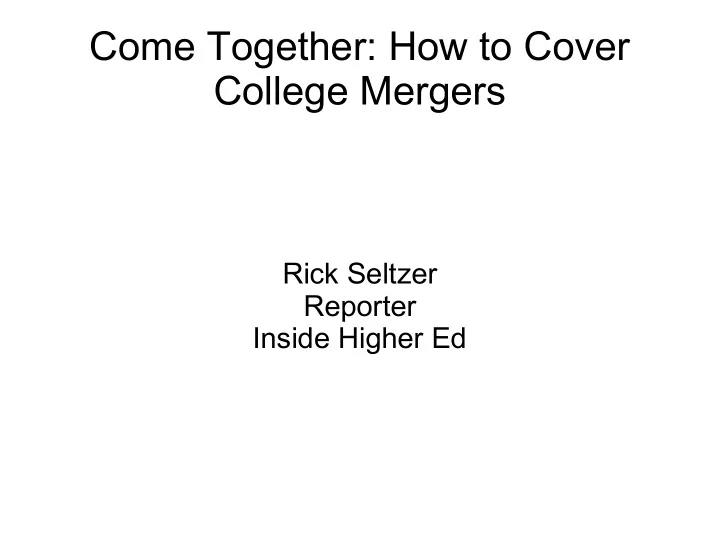

Come Together: How to Cover College Mergers Rick Seltzer Reporter Inside Higher Ed
Who Are You Listening To? Reporter at Inside Higher Ed for 2-1/2 years Previously a business reporter Covered corporate mergers and acquisitions Covered college mergers and acquisitions This year wrote a special report on higher ed mergers
$149 Targeted toward presidents or trustees https://www.insidehig hered.com/content/gr owing-role-mergers- higher-ed
Why talk about this now?
It's not that simple.
It's even more complex Projections differ by state. Go to https://knocking.wiche.edu/ if you want to read the projections yourself. The report is from December 2016. Things have changed since then. Different types of colleges will feel these changes differently.
Mergers aren't new EAB counted 250 mergers proposed between 1830 and February 2018. Prominent examples: Carnegie Melon created through a merger in 1967 Case Western Reserve created by merger in 1967, Yale acquired Andover Newton Theological School in 2017 Boston University acquired Wheelock College in 2018.
How will a merger come together? Public announcement usually months before a deal is consummated Private universities often announce after they have a non-binding memorandum of understanding. This means they'll have the basic structure hammered out, like name and governance structure Key constituencies could still weigh in Public universities are messier
Catching wind early Privates can be hard A small number of leaders involved Nondisclosure agreements Trustees, key administrators and consultants Publics have more cooks in the kitchen Administrators, unions, and local politicians will all want to be told Studies commissioned before specific plans are proposed Are any brokers or foundations involved?
How do you cover a merger? Who gets control? Who gets to stay open? Who gets the short end of the stick?
Who gets control? Which board members are staying? What executives and administrators are keeping their jobs, moving to new jobs or retiring? What's happening to the legal entities?
Who gets to stay open? Which programs are continuing under the merged institution? Which buildings are being kept open? What land is being redeveloped, sold or held for an undecided future use? What names are living on, and how?
Who gets the short end of the stick? Staff losing their jobs? Faculty losing their jobs? Students changing programs? Campuses closing and cutting student access? Fewer seats cutting student access? Tuition going up?
Other important questions Is one side more prestigious than the other? What happens to the endowment? State regulators Accreditors Any other legal issues?
Organized mergers Don't have doom hanging over them Both sides are relatively financially healthy, even if they face pressure Both sides are at the table willingly Follow a process Not everyone has to agree a merger is a good idea Acknowledge benefits and drawbacks There will still be stories of chaos along the way Think of Boston University and Wheelock
Disorganized mergers Are done at the last second One college will often be facing impending doom Key constituencies aren't told early Large groups aren't on board Agreements or bond covenants aren't considered Sides show inflexibility when unexpected issues arise Think of Mount Ida College and Lasell
Further reading Coverage of interesting cases: Boston University and Wheelock Mount Ida and Lasell Public colleges in Georgia Connecticut community colleges Salem State University and Montserrat College of Art AP Stylebook's business guidelines have a section on mergers and acquisitions
Questions? Comments? Insults?
Follow up Reach me at rick.seltzer@insidehighered.com if you want to ask any questions.
Recommend
More recommend